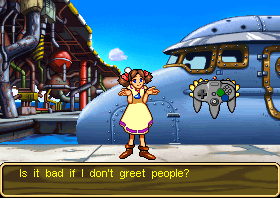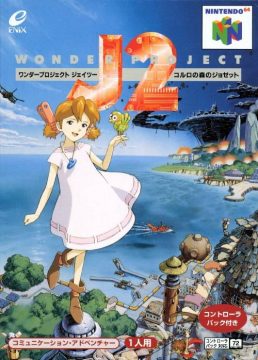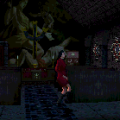- Wonder Project J
- Wonder Project J2
The second Wonder Project came out on the N64, roughly two years after the first game. It was developed by the same team, albeit having undergone a name change from Almanic to Givro; again published by Enix. It arrived at a time when the 3D obsession on consoles was in full swing, and N64 owners in the West would soon be getting to grips with Turok and Star Wars – in short, it didn’t stand a chance of being localized. While WPJ2 suffers from several shortcomings and pacing issues, it’s one of the forgotten gems of the N64 and that era. In 2007 though it was fan-translated, by a gentleman named Ryu, making it much more accessible. The translation isn’t perfect, with some unnecessary and excessive use of swearing, and a lack of continuity with the excellent fan-translation of the first game (Rob & Ber have the more literal translations of Doro & Bou, which is lost on English speakers), but it’s still a fantastic achievement.
Set roughly 15 years after the first game, the story starts with the revelation that the evil Gijin Messala is still alive, now existing as a disembodied and mechanically augmented floating head. In a conversation with the shadowy Emperor Siliconian XIII it’s revealed that the mysterious substance J (which formed the basis of Circuit J in the first game), is with a Gijin girl on Corlo Island. Messala is ordered to retrieve it by any means necessary. Cut to peaceful Corlo Island and, perhaps sensing something, Dr Geppetto explains to the Gijin girl he’s created (named Josette by default), that she must travel to the island of Blueland. She cries she doesn’t want to go, he promptly keels over and then, while on his sick bed, explains that a mysterious “player-san” from another world will help look after her. Then the good doctor dies. Cue the cinema showing Josette arriving on Blueland (or more accurately the adjacent Megafloat Noah island) with the help of two familiar faces (Rob & Ber), and the start of a whole new adventure examining the human condition.
The story is a bit more complex than the first, involving an evil Empire (the Siliconians), the powerful substance J which could end the world, various wicked experiments on Gijin, and a band of freedom fighters plotting to overthrow the government. If you’ve played the first game there’s a lot of continuity with the sequel, and while it’s not essential, it’s great to see returning characters (or their children) and how they’ve changed over the years. The cast this time around is also much bigger. Here’s just a few of the more important ones you’ll bump into:
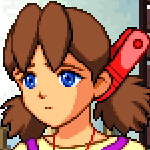
Josette (AKA: Model 5984)
The heroine of the story, she’s a teenage Gijin girl created by Dr Geppetto, and is in possession of the mysterious substance J, which holds incredible power. She’s nowhere near as naughty as Pino was, though is still prone to eating things she shouldn’t. Over the course of the game she’ll develop an affinity for “player-san”, a figure shaping her destiny in a world she cannot see.
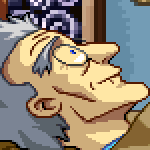
Dr Geppetto
The old man from the first game returns, and then promptly dies. Later on you encounter Fam again from the first game, who reveals more of the doctor’s motivations and why he came to create two human-like Gijin children.
Bird (AKA: Interface Robot Model 5980)
Replaces Tinker from the first game; he’s your mouse pointer for interacting with Josette. Note, he isn’t able to hit Josette around the head like Tinker could with Pino, and instead holds up a red card for very bad mistakes.
Doro & Bou
The fan-translation should have had them as Rob & Ber, but no matter. These two take you to Blueland island, and later on help out with the revolution. Notice how they’re still wearing face masks, except now they’re for aviation, not thieving.
Karen
Recognize her? Probably not without her feline mask. She’s the thief Lynx from the first game, except now with a husband and child. She has fond memories of Pino though, and shows kindness towards other Gijin such as Josette.
Galon
Karen’s estranged husband. He’s gone off and become the leader of a band of revolutionaries intent on overthrowing the government. To do this he teams up with some sea pirates.
Sapphire
The strong-willed and rebellious daughter of Karen and Galon, she’s about Josette’s age. Don’t let her youth fool you though, she’s a skilled fighter and always tries to protect those weaker than her.
Pokko
Looks familiar, doesn’t he? It turns out he’s the son of Princess Tiffany, the next heir to the Corlo throne, and yet somehow also the reincarnation of mechanical Pino. It doesn’t make any sense, and is kind of creepy, but just go with it.
Gante
An engineer who studied in the same class as Dr Geppetto. He may seem brusque and grumpy, but he’s actually a big softy who cares for Josette. Later on he steals and hides a Seaba attack plane, which unlocks a minigame for Josette.
Fisher
Local fisherman who teaches Josette her first greeting. He also inducts you into the world of fishing, and gives you the secret passcode for the underwater door (B, B, B, A), which allows Josette to enter the submarine races! Later on his wife gives birth to a son.
Rostam, Ridal, Horus
Three local fishermen who cause trouble with the Siliconian authorities, but are generally good natured. Later they join the revolution.
Arnold
A young man with an important secret, he’s Josette’s first crush and helps her to understand what love is. Later on you discover his sad past, and how it connects to the Siliconian Empire.
Pearl
Daughter of the mayor; self-centered, lazy, vain and a total bitch. Starts off friendly to Josette, but after Josette lands an actress role in a local film and steals the heart of Arnold, she turns all mean and spiteful. Has a trio of friends who hang on her every word.
Clara
A small blind girl who Josette befriends. She falls very ill from a mysterious illness later on, and Josette help find a cure for her by aiding Kurohige, a traditional healer who visits the island.
Fam Wizard
Another familiar face from the first game (the farmer, remember?). He reveals himself to be a 3000-year-old wizard, descended from a species of sentient lizards which evolved from dinosaurs, and is now the protector of substance J.
Harben
An army leader who appears kind-hearted towards the local citizens. He has one of his subordinates executed for harassing and threatening them. Also a master of martial arts whom Josette must later duel with. If you search the alley you can find the ghost of his father for some advice.
Dr Frahken
Possibly named after Dr Frankenstein from the famous novel, this insidious fellow likes experimenting on Gijin, all in the name of the Siliconian Empire! Is a complete coward when the crap hits the fan later on.
Gijin #46
We said he’d make a return. The twisted Dr Frahken disassembled and rebuilt him into this grotesque monstrosity, as a weapon of mass destruction. But he didn’t wipe his pure heart, and rather than kill innocent people, #46 recalls happier days on Corlo and then sacrifices himself.
Messala the 3rd
Will nothing stop this guy? Messala returns, though doesn’t pop-up nearly as often as before. He’s also not as well rounded a villain this time. In the second chapter he starts causing mayhem and destruction, but is destroyed by one of his own weapons.
Siliconian XIII
The mysterious main villain of the story. There’s a big reveal at the end, which we won’t spoil. Or will we?!… No, we won’t. We’re just adding words here to fill out the space… Oh, go on then! The evil emperor is in fact Dr Geppetto in disguise.
Broadly speaking it’s very much the same as the first game, in terms of mechanics, theme and story. Though there’s considerable fleshing out as to the origins of substance J. It’s also just as dark and sinister beneath its cute cartoon exterior, if not more so, with experimentation on certain Gijin, and entire nations being wiped out.
As before you need to teach Josette various skills so she can pass obstacles and trials, all through repeatedly using certain objects. For example, using a dumbbell to increase strength so she can break chains. The main difference is that while the original WPJ had a series of stats bars showing precisely where skill had been gained, all such variables remain hidden in WPJ2. On the plus side, it doesn’t seem possible anymore to decrease any skills through neglect, which makes things much easier. In fact everything has been overhauled to be simpler. Whereas before Pino had to specifically practice his balancing and kicking a ball to build leg strength and walking proficiency, Josette does this automatically through other interactions. There are no balls to kick, though until she learns the proper use for something she’s likely to kick it anyway, which builds those stats.
Conveniently, if you need any items you can now buy them in Josette’s living area, rather than having to traipse to a shop like before. There are also far fewer places to interact with objects. Mostly this can only be done from the starting area (a submarine called the Dolphin), with other locations visited tending to be automatic cut-scenes. Click on somewhere like Karen’s pub, the park, or anywhere else, and events play out like on their own, with Josette either passing or failing at an obstacle – unlike before where you could directly order Pino about in each area. It’s definitely a narrower game, in terms of control, even though the actual progression is fairly open-ended. You can meet people and aim towards specific goals in any order. Josette has a set of 25 Achievements she must accomplish, including learning to wash herself, sing, pilot an aeroplane, tell the future, and so on. As each one is completed, a new flag is triggered inside the game, opening up further scenes. This only occurs during chapter 1 though, which is the gameplay portion. As some reviewers have accurately noted, chapter 2 is more like an extended ending, tying up all the loose ends, concluding major arcs, and lasting roughly an hour. This might seem really long, but rest assured it’s probably one of the most satisfying endings found in a videogame.
The other big change is the inclusion of 3D action sections. There’s still a 2D maze dungeon like in the first game, inside the island’s giant Goddess Statue, but in addition to this is a behind-the-shoulders 3D maze inside the local mine, another inside an old temple where you need to rediscover Josette’s memories, and a first-person maze at the game’s climax. The latter two are mandatory. In addition there’s an underwater action sequence where you can catch fish and search for lost treasures in a submarine, and another where you fly an aeroplane while shooting down fighters and drones.
Unfortunately all of these 3D sections are utterly dreadful. The 3D mazes all have 90 degree tank controls, like something out of the 1980s, and have some of the worst polygonal models you’ll see on the N64. The mine area is just boring, repeatedly switching to 2D screens to jump gaps, walk planks or fight bats and monsters. The temple area is worse, since you need to find a doppelganger of Josette inside the maze to answer her question, except she seems to materialise randomly inside the maze (aaargh!) and you need to hunt her down 20 times! Awful, just awful. The first person maze at the end is a mad sprint while avoiding enemies, but you normally only see them when they’re right on top of you, and if you get caught you need to restart the section over (put aside A LOT of spare time to do this, unless you’re emulating). If you’re emulating there’s also a graphical glitch in this area, blocking most of the screen. As for the underwater and flying segments, they take place inside a viewing box the size of a postage stamp, with superfluous junk like Josette’s head and control panels taking up the rest of it, making it virtually impossible to see anything. Thankfully these two are entirely optional.
It’s a shame the developer felt the need to tack these extra bits on, because they don’t really add anything, and are unquestionably the low points in the game. Though there is a fairly cool submarine race Josette can participate in, which is tolerable by virtue of being non-interactive. Otherwise it’s business as usual, getting Josette to build her skills, interacting with the locals, solving problems, making friends, and growing as a person. She also asks the player a bunch of questions, which only require a yes or no answer, but are a nice touch. The game feels more forgiving than the first, with no discernable permanent Game Over screen.
As before it also features some utterly gorgeous 2D spritework, with even more frames of animation than before. It’s astonishing this exists purely as a cartridge release. This exquisiteness is reduced slightly on an actual N64, which tends to blur everything unless you’ve had it RGB modded for a crisper picture, but if emulating the game with the Rice graphics plug-in, there’s perfect pixel fidelity. There’s also a strong cinematic feel, with some excellent emotional character development. You’ll come to genuinely care for Josette and the people she meets, and as you help her develop as a person she express her gratitude. When Clara falls ill, or Fisher’s wife gives birth, or the director and his assistant make a film which defies the authorities, it feels like you’ve been accepted into a small community, watching their lives develop. Likewise when you witness people that you’ve come to know being executed, all but the coldest of players will feel a chill.
Like before, it’s not a fast paced game, but it’s a unique experience on the N64, unlike anything else and with plenty of charm (it even came with a nifty little themed controller memory pak). In fact in the grand pantheon of videogames, there are few other games like it – notably there’s Nanatsu Kaze No Shima Monogatari, also by Almanic/Givro. In 2010 Square-Enix re-released WPJ2 for mobile phones, tweaking it to suit a more vertical display, and modifying the 3D sections.
Long-time fan of the series, Kristina Potts, sums up the melancholy of WPJ2: “In addition to the composer Akihiro Mori dying not that long after WPJ2, Givro also dissolved after its release. I think it gives completing WPJ2 an extra emotional twinge, since it really was the end of the line, for the franchise, the developer, and the composer. I was very surprised when WPJ2 was revived with the mobile version, although I’m doubtful that the franchise will ever be brought back in any other form. Not that I’d really want it to. I’d rather leave it on a high note than consider how different developers could potentially muck up a remake/sequel.”
For fun, here’s the review from N64 magazine in the UK, in their launch issue. Written by Wil Overton (a legend in the UK), it only scored 55% – though in fairness this was due to the language barrier, and the magazine gave it more time and a better score than other publications which imported it. Here also are those famous pages scanned from Nintendo Power issue 96, which introduced WPJ2 to a lot of people. GameFAN magazine also had coverage, in issue 50.
Many thanks to Kristina Potts, aka Succubus on the HG101 forums, for much assistance and use of photographs.
Links:
http://membres.multimania.fr/wonderproject/ – the best (only?) fansite for WPJ2 in English.
http://www.square-enix.co.jp/mobile/sem/wpj2/ – official Square-Enix page for WPJ2 on mobile phones.
WPJ1 – fan-translation page on RHDN.
WPJ2 – fan-translation page on RHDN.
Prototype sketches from Famimaga 64 magazine, courtesy of Kristina Potts. Click for larger versions and extra material, plus related text (Japanese).
Merchandise
There was all manner of merchandise released in Japan for the two Wonder Project J games. For the first there were multiple guide books, a “game book” (think choose-your-own-adventure), plus several volumes of manga. For the second game there was even more stuff. Several manga, including one by Raka Masaki, adapted from the game and with a story that’s described as “quite different” from the game. There was also a silly but fun series of Yonkoma (four-panel) manga. The official soundtrack, by Akihiro Mori, was released on CD. WPJ2 was his last soundtrack as he sadly died not long after. He wasn’t very prolific, but he’s well appreciated by those familiar with his work and many of his soundtracks go for big money these days. There was also a phone card for WPJ2 and, mysteriously, a “desktop utilities” CD-ROM.

